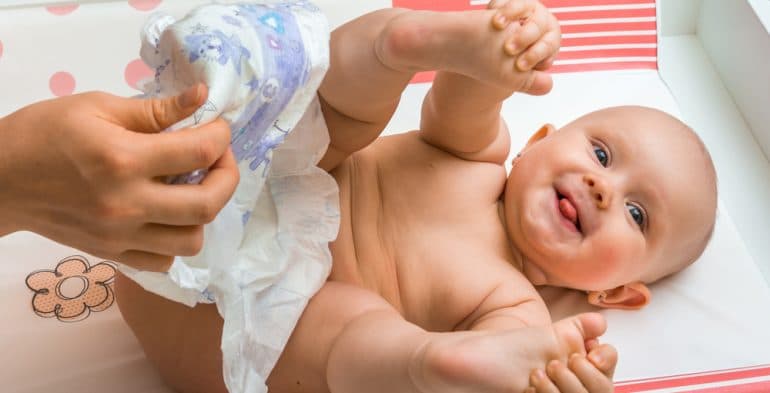
Everything you need to know about diaper changing
Not everyone knows how to change a diaper. Some of people may even be too embarrassed to ask. You shouldn’t be and you can ask your midwife or health visitor for help. But for those who are still worried, we have produced a definitive guide to diaper changing!
Disposable or cloth diapers?
These days nearly everyone uses disposable diapers. They are so much easier to handle and far less messy. However some of you might still prefer the less wasteful old fashioned way. That’s up to you, and apart from the washing and drying the method is pretty much the same.
When to change a diaper
Diapers should be changed as a matter of course after feeding, when the baby wakes and whenever the baby cries or appears in discomfort. You must not let your baby sit in a dirty diaper as both poop and pee can cause irritation to the skin. Usually the smell will let you know that a change is needed but every few hours is a minimum.
How to change a diaper
- To start changing the diaper, you must wash your hands before anything else. If that is not possible, a hand sanitizer could be used instead.
- Before starting, ensure that all the needed equipment is available on the changing table and within arm’s reach. If not, make sure to restock all your need before you start.
- Place the baby carefully on a clean, soft and safe surface, whether on the changing table or on a changing pad placed on a dresser, desk, crib, bed or even on the floor. Use a waterproof pad to avoid wetting the underneath surface. Keeping one hand on the baby during the whole changing process is essential to avoid accidents. Even if your baby has not yet rolled they soon will!
- Open the dirty diaper. If it is just wet, then fold it underneath the baby having the clean outer side under the baby’s bottom. Use lukewarm water to wash the baby’s bottom. If there isn’t running water close by, or you prefer, use wipes, soft wash clothes or cotton balls to clean the area.
- For baby boys, when opening the dirty diaper, make sure you cover the baby’s penis with a clean diaper or towel as fresh air can cause baby boys to pee.
- If the diaper contains poop, then the diaper should be used to wipe off as much poop as possible before turning to the wipes. Lift the baby’s legs to clean his bottom and the creases between his legs.
- For baby girls, make sure to wipe from front to back to avoid spreading infections from soiling into the vaginal area.
- Use a soft cloth or towel to pat the baby’s bottom until it is completely dry. Slather diaper cream and ointment on dry skin to avoid diaper rash.
- Slip the new diaper underneath the baby while removing the old one and fastening the new diaper’s tabs. For baby boys, make sure the penis is pointed down when putting the new diaper to minimize leaks.
- For disposables, wrap the diaper into a ball, using the tab fasteners to secure, then thrown in the diaper pail or waste bin. Cloth diapers should be placed in a bucket with a tight cover until laundry day. If the diaper contains loose stool, then the stools should be dumped in the toilet and flushed before placing the diaper in the pail or laundry bucket.
- Make sure to wash your hands using soap and water or using a hand sanitizer.
- Re-dress the baby or change his clothes if needed.
Diaper hacks
- Every baby is different regarding the number of diapers he/she will be using daily. Expect an average of 10-12 daily.
- Usually the right diaper size will fit well around your baby’s legs. If you experience frequent leaks, this is an indication that you should change the size of the diaper.
- Make sure to keep one hand on the baby during the whole changing time for the baby’s safety.
- For easy diaper changing, use distractions to keep the baby occupied, try singing a song, giving the baby a toy or teeth ring or a binky, or playing a game are all good ideas.
- It is always wise to make sure the baby has finished pooping before you start changing the dirty diaper.
- In order to guarantee that the baby can sleep well through the night without getting wet, a cloth or disposable doubler could be inserted to the diaper. Doublers are thick cloth or disposable pads that add extra absorbency at night. Other options are overnight diapers and changing the baby before you go to bed or after a late night feed.
Possible causes of diaper leaks:
- If the baby is only 2 weeks old or younger, then maybe the diaper is lying over his/her umbilical cord stump. Fit the diaper snugly below the stump to fix this issue.
- The diaper size may not fit the baby well and should be reconsidered.
- The diaper maybe fastened loosely. Close it tighter to fix the issue.
- The baby is between two sizes; in this case wait a bit and this issue will sort itself out.
Learn about your baby’s diaper needs by watching them
Your baby is individual and his requirements will be also. You will soon get into a routine of understanding when your baby needs changing, how frequently and what his/her habits are so you can be prepared when out and about and at home. You will be amazed at how good you will become at predicting your babies habits and when to expect diaper changes.
If you are worried that you won’t be able to cope with the mess and the smell – don’t be! Your love for your new baby will override every other factor and you will even find yourself enjoying the time you spend close to them…








